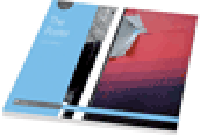CFP: The Poster (new journal; ongoing)
 Here at Comics Research & Such, we're giving a warm welcome to The Poster, another new journal from Intellect, publisher of the forthcoming Studies in Comics. While The Poster's CFP doesn't mention comic art as such, I can see lots of room here for such work, particularly for scholars or practitioners of gallery comics, as well as museum/gallery denizens of all stripes. First, a bit about the journal itself:
Here at Comics Research & Such, we're giving a warm welcome to The Poster, another new journal from Intellect, publisher of the forthcoming Studies in Comics. While The Poster's CFP doesn't mention comic art as such, I can see lots of room here for such work, particularly for scholars or practitioners of gallery comics, as well as museum/gallery denizens of all stripes. First, a bit about the journal itself:The Poster is a forum for the study of visual rhetoric in the public sphere; a place to discuss how and why visual messages are thrust into the world and the media forms used to do so. This peer-reviewed journal stands as a vehicle for the ideas of media theorists; scholars of Cultural Studies and Cultural Materialism; for social psychologists of visual communication, for architects and designers of wayfinding schemes; for philosophers of Aesthetics and Politics, Society and Linguistics; for social scientists, anthropologists and ethnographers; for political campaigners and artist activists; for communications researchers and visual communications practitioners.
[...]
The Poster stands as a privileged symbol of visual rhetoric manifest in the world, and as such visual rhetoric is the heart of this journal. Once the poster was a simple beast, it's role was that of a focused shout; a singular message delivered as powerfully as could be devised into the melee of the public sphere. As such every rhetorical visual form intended to sway hearts and minds; from Luther's Thesis nailed to the church door in Wittenberg to that glorious symbol of Western civilization that is Times Square in New York City; could easily fall within the journal's purview. As the visual rhetorical impulse grows ever stronger; with every miniscule social group having the means and media savvy to visually project their case into the public sphere; the material nature of the poster is in flux. Things are changing and this change is the founding impulse behind the creation of the journal.
[...]The journal is actively looking for both theoretical and practice based contributions to it's refereed content, but also recognises that many with an active interest and expertise in the area are from outside the academic sphere: to this end we invite those who contribute vitality to the visual rhetorical landscape to send in their work as non-refereed submissions.
And here's the Call for Papers:
The journal The Poster has been founded as a forum to promote debates around the following issues:These are urgent issues in our increasingly mediated world. The act of making persuasive interventions is a massively multidisciplinary process: the effect of these interventions is of vital importance in promoting public dialogues and forming healthy political structures.
- The ways in which visual devices are used to sway, persuade, provoke, unite and divide us.
- The impulse behind the use of visual means to make rhetorical points.
- The means that are deployed to make such visual rhetorical points.
- How the material nature and placement of the means affects the rhetoric.
- If it is even possible to effectively direct understanding through visual rhetorical means.
Political actions succeed or fail on their ability to engage with a heterogeneous mass of actors, uniting them in a common cause. Public health campaigns either function or people die. If successful communications shape global patterns of consumption, perhaps they could save the world? If visual rhetorical systems possess this persuasive power shouldn't we explore their limits and find the wisdom to use them well. In exploring these issues we are seeking textual and visual practice submissions on the following subjects:If you have an interest in any of these areas we would encourage you to make a submission.
- What is meant by 'Visual Rhetoric' and 'The Public Sphere'?
- Why the poster stands as a symbol for visual rhetorical practice: A privileged signifier of rhetoric, over and above every other instance of the visual which also persuades or affects behaviour…and if so, why and how?
- What new forms have taken up the torch of visual rhetorical action?
- Does the poster still have a role in the panoply of visual rhetorical media?
- In a networked world who now owns and controls the means of rhetorical production?
- What alternative/critical projects and strategies are possible and how will these new visual rhetorical manifestations operate?
- To what degree it is possible to influence people's hearts and change people's minds through visual rhetorical means?
- Is it possible to create a neutral information vehicle that informs in a non-partisan way?
- Is there a difference between visual and other forms of rhetoric?
- Do visual rhetoricians have a moral responsibility for the means they put at the disposal of their clients and the messages they devise?
- Is it possible to create an analysis system appropriate to posters?
Submissions can be theoretical or philosophical in nature, from essays on industrial practice (e.g. successful campaigns, analysis of trends and methods) to visual artefacts from practitioners in the field of visual communication (e.g. Graphics, Illustration, Curation, Experience Design, Photography, etc.).
Labels: academic, cfps, gallery comics, intellectual property, posters, visual rhetoric



